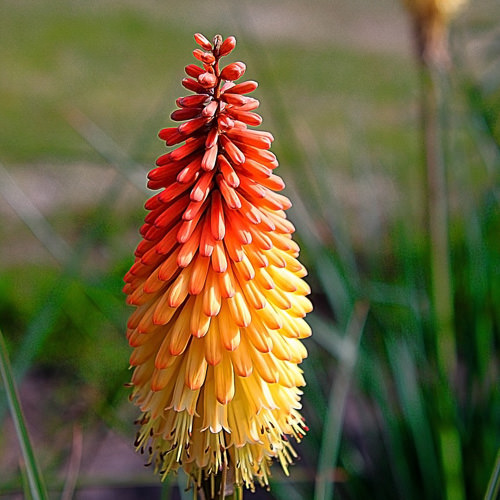How to Care for a Red Hot Poker Plant Although this beautiful plant is hard and moderately drought resistant, regular water is required in order for the plant to reach its full potential. Gardeners should be diligent with watering during hot and dry spells.
Torch lily (Kniphofia uvaria), also known as red hot poker, is a dramatic plant with long, spiky blooms that appear from late spring until autumn. The blooms resemble a torch or rocket, as the lower part of the spike is creamy yellow while the upper part is intense red or orange. At maturity, the plant reaches heights of 2 to 5 feet. Torch lily is suitable for growing in U.S. Department of Agriculture plant hardiness zones 5 through 9.
1
Plant torch lilies in bright sunlight and well-drained soil. Torch lily performs best when planted in soil with a neutral soil pH between 6.6 and 7.0.
2
Spade 2 to 3 inches of compost or manure into the soil at planting time to improve soil drainage and quality. Allow 18 to 24 inches between each plant.

3
Provide torch lilies with about 1 inch of water every week during warm weather, or enough to saturate the soil to a depth of 5 to 6 inches. Don't allow the soil to become bone dry during the summer, as dry soil causes decreased blooming. Conversely, let the soil dry slightly between each irrigation, as waterlogged soil often results in root rot.
4
Feed the plant before new growth emerges in early spring, using a general-purpose dry fertilizer applied at the rate recommended on the package. Sprinkle the fertilizer on the soil around the plant, and then water deeply.
5
Remove wilted flowers to promote continued blooming throughout the season. Otherwise, the plant goes to seed and enters dormancy early. Cut blooms for cut flower arrangements as often as you like.
How To Sow Red Hot Poker Seeds
6
Leave the foliage in place when the plant stops blooming in autumn, because the green foliage absorbs energy from the sunlight, which the bulbs store for growth the following year. Wait until the foliage turns yellow, and then cut the plant down to the ground.
Things You Will Need
- Spade
- Compost or manure
- General-purpose dry fertilizer
- Pruners or garden shears
References (4)
About the Author
M.H. Dyer began her writing career as a staff writer at a community newspaper and is now a full-time commercial writer. She writes about a variety of topics, with a focus on sustainable, pesticide- and herbicide-free gardening. She is an Oregon State University Master Gardener and Master Naturalist and holds a Master of Fine Arts in creative nonfiction writing.
Cite this Article